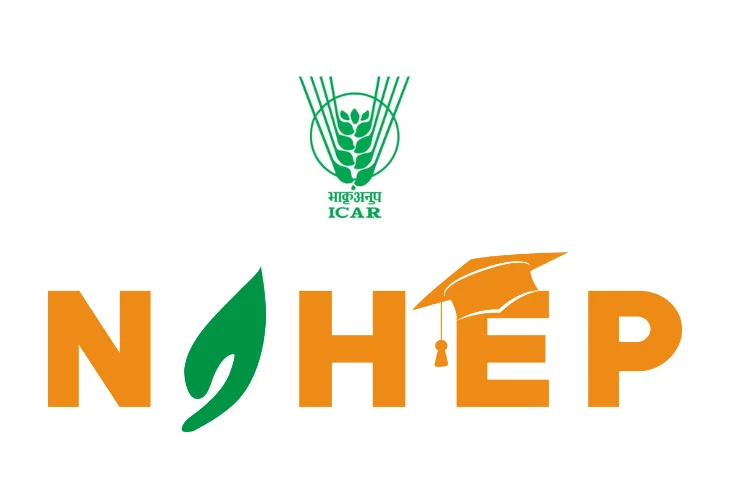The National Agricultural Higher Education Project (NAHEP) is an initiative by the Indian Council of Agricultural Research (ICAR) in collaboration with the World Bank. The project aims to enhance the quality, relevance, and global standards of agricultural education in India.
By strengthening the infrastructure, improving curriculum, and enhancing faculty development, NAHEP seeks to prepare graduates with the necessary skills and entrepreneurial mindset to contribute effectively to the agricultural sector.
Launched in 2017-18 for a period of five years, the project is based on a 50:50 cost-sharing model between the Government of India and the World Bank. Through this partnership, NAHEP ensures a systematic approach to modernizing agricultural higher education while promoting international exposure and industry linkages.
Why was NAHEP Initiated?
Agriculture remains a critical sector in India, providing employment to nearly half of the country’s population. Despite its importance, agricultural education in India had been facing challenges in terms of outdated curriculum, limited research opportunities, and insufficient industry collaboration. NAHEP was initiated to address these gaps by:
- Improving Quality: Bringing Indian agricultural universities on par with international standards.
- Enhancing Relevance: Ensuring graduates have practical skills and entrepreneurship capabilities aligned with sector needs.
- Strengthening Resources: Upgrading infrastructure, promoting faculty development, and supporting student advancement programs.
What are the Main Objectives of NAHEP?
The project focuses on several core objectives that target the overall improvement of agricultural education:
- Modernize Education and Research: Introduce innovative teaching methods, contemporary research facilities, and skill-oriented programs.
- Foster Industry Linkages: Encourage collaboration between universities and agribusiness sectors to provide students with practical experience and opportunities.
- Promote Centers of Excellence (CoE): Establish specialized centers in fields like climate-smart agriculture to focus on advanced research and skill development.
- International Exposure: Facilitate participation in global programs to enhance faculty and student competence.
- Entrepreneurship Orientation: Support students in developing entrepreneurial skills and career pathways in agriculture.
Also Check: List of Government Schemes of India
How is NAHEP Funded and Managed?
NAHEP operates under a 50:50 cost-sharing arrangement between the Government of India and the World Bank. This funding ensures adequate financial resources for infrastructure development, capacity-building initiatives, and research investments.
| Aspect | Details |
| Implementing Agency | The Indian Council of Agricultural Research (ICAR) leads the implementation, ensuring alignment with national education policies and agricultural priorities. |
| Duration | The project is designed for a five-year period starting from 2017-18. |
| Project Management | The management framework focuses on effective planning, monitoring, and learning across participating agricultural universities. This ensures that the project achieves its objectives efficiently and sustainably. |
Check Out: Complete List of Important Schemes for NABARD Grade A Exam
What are the key components of NAHEP?
NAHEP has three major components that structure its interventions:
1. Support to Agricultural Universities
This component focuses on enhancing the quality and relevance of agricultural education and research in participating universities. Investments under this component include:
- Upgrading laboratories and teaching infrastructure
- Supporting faculty development programs
- Encouraging curriculum redesign to meet industry needs
- Providing resources for research and innovation projects
The ultimate aim is to create an environment where students gain practical knowledge and skills required for agricultural transformation.
2. Investments in ICAR for Leadership
The second component strengthens ICAR’s role as the leader in agricultural higher education. It includes:
- Enhancing governance and institutional capacity
- Developing policies for quality assurance and accreditation
- Promoting innovation in teaching, research, and evaluation methodologies
Through this component, ICAR can guide agricultural universities toward global standards in education and research.
3. Project Management and Learning
Effective project management is critical to achieving NAHEP’s goals. This component ensures:
- Proper planning, monitoring, and evaluation of project activities
- Sharing best practices among universities
- Continuous learning to adapt strategies for better results
Get ready to crack government job exams with leading educators
What Initiatives and Impacts has NAHEP Achieved So Far?
NAHEP has recorded several notable achievements that highlight its transformative potential:
| Initiative | Details |
| Centers of Excellence (CoE) | Specialized centers have been established in areas like climate-smart agriculture, enabling focused research and skill development. |
| Accreditation | Eleven agricultural universities have successfully achieved ICAR accreditation, ensuring quality standards in education. |
| International Exposure | Over 900 faculty members and 2,000 students participated in international programs, fostering global competencies. |
| Industry Linkages | More than 650 MOUs have been signed between universities and industry partners, encouraging practical learning and employment opportunities. |
| Entrepreneurship Development | Students have been motivated to explore entrepreneurial ventures, with dedicated career development support. |
How does NAHEP Contribute to National Development?
NAHEP’s relevance extends beyond academic excellence. By producing skilled graduates, the project:
- Strengthens the agricultural workforce with practical and innovative skills
- Supports sustainable agricultural practices, including climate-smart techniques
- Encourages entrepreneurship, creating new opportunities in rural and urban sectors
- Enhances international collaboration and global competitiveness of India’s agricultural education
Key Takeaways
| Aspect | Details |
| Implementing Agency | Indian Council of Agricultural Research (ICAR) |
| Funding | 50:50 cost-sharing between Government of India and World Bank |
| Duration | 5 years (2017-18 onwards) |
| Main Goals | Improve quality, enhance relevance, strengthen resources |
| Key Components | Support to Agricultural Universities, Investments in ICAR, Project Management & Learning |
| Centers of Excellence | Climate-smart agriculture, skill development |
| International Exposure | 900+ faculty, 2,000+ students participated |
| Industry Linkages | 650+ MOUs signed with industries |
| Entrepreneurship | Focus on student entrepreneurship and career development |
| Relevance | GS Paper 3, agriculture education, skill development, climate change |
Questions Based on NAHEP
- Who is the implementing agency of NAHEP?
a) Ministry of Education
b) Indian Council of Agricultural Research (ICAR)
c) University Grants Commission (UGC)
d) Ministry of Agriculture
e) World Bank - What is the funding pattern for NAHEP?
a) 100% Government of India
b) 50:50 between ICAR and World Bank
c) 50:50 between Government of India and World Bank
d) Fully World Bank funded
e) Public-Private Partnership - Which of the following is NOT a component of NAHEP?
a) Support to Agricultural Universities
b) Investments in ICAR for Leadership
c) Skill development for farmers
d) Project Management and Learning
e) All are components - NAHEP was launched in which year?
a) 2015
b) 2016
c) 2017-18
d) 2018-19
e) 2019 - Which specialized area has NAHEP focused its Centers of Excellence on?
a) Digital marketing
b) Climate-smart agriculture
c) Artificial intelligence
d) Rural banking
e) Renewable energy - How many universities have received ICAR accreditation under NAHEP?
a) 5
b) 8
c) 11
d) 15
e) 20 - What is the duration of the NAHEP project?
a) 3 years
b) 4 years
c) 5 years
d) 6 years
e) 7 years - How many MOUs with industries were signed under NAHEP?
a) 500
b) 650
c) 700
d) 750
e) 800 - Which of the following is a key objective of NAHEP?
a) Provide free seeds to farmers
b) Modernize agricultural education and research
c) Subsidize fertilizers
d) Offer crop insurance
e) Increase food exports - How many students participated in international programs under NAHEP?
a) 500
b) 1,000
c) 2,000
d) 3,000
e) 4,000
Also Read:
Answer Key
| Question No. | Correct Answer |
| 1 | b) Indian Council of Agricultural Research (ICAR) |
| 2 | c) 50:50 between Government of India and World Bank |
| 3 | c) Skill development for farmers |
| 4 | c) 2017-18 |
| 5 | b) Climate-smart agriculture |
| 6 | c) 11 |
| 7 | c) 5 years |
| 8 | b) 650 |
| 9 | b) Modernize agricultural education and research |
| 10 | c) 2,000 |
- MISHTI Scheme, India’s Initiative to Restore Mangrove Ecosystems
- National Green Hydrogen Mission Features, Objectives, and Benefits
- Paramparagat Krishi Vikas Yojana, Transforming India’s Organic Farming
- Mission on Integrated Development of Horticulture NHM and HMNEH
- Swachh Bharat Mission, India’s Journey Towards Cleanliness and Hygiene
- SAGY, A Step Towards Holistic Development of Indian Villages

Hi, I’m Aditi. I work as a Content Writer at Oliveboard, where I have been simplifying exam-related content for the past 4 years. I create clear and easy-to-understand guides for JAIIB, CAIIB, and UGC exams. My work includes breaking down notifications, admit cards, and exam updates, as well as preparing study plans and subject-wise strategies.
My goal is to support working professionals in managing their exam preparation alongside a full-time job and to help them achieve career growth.
